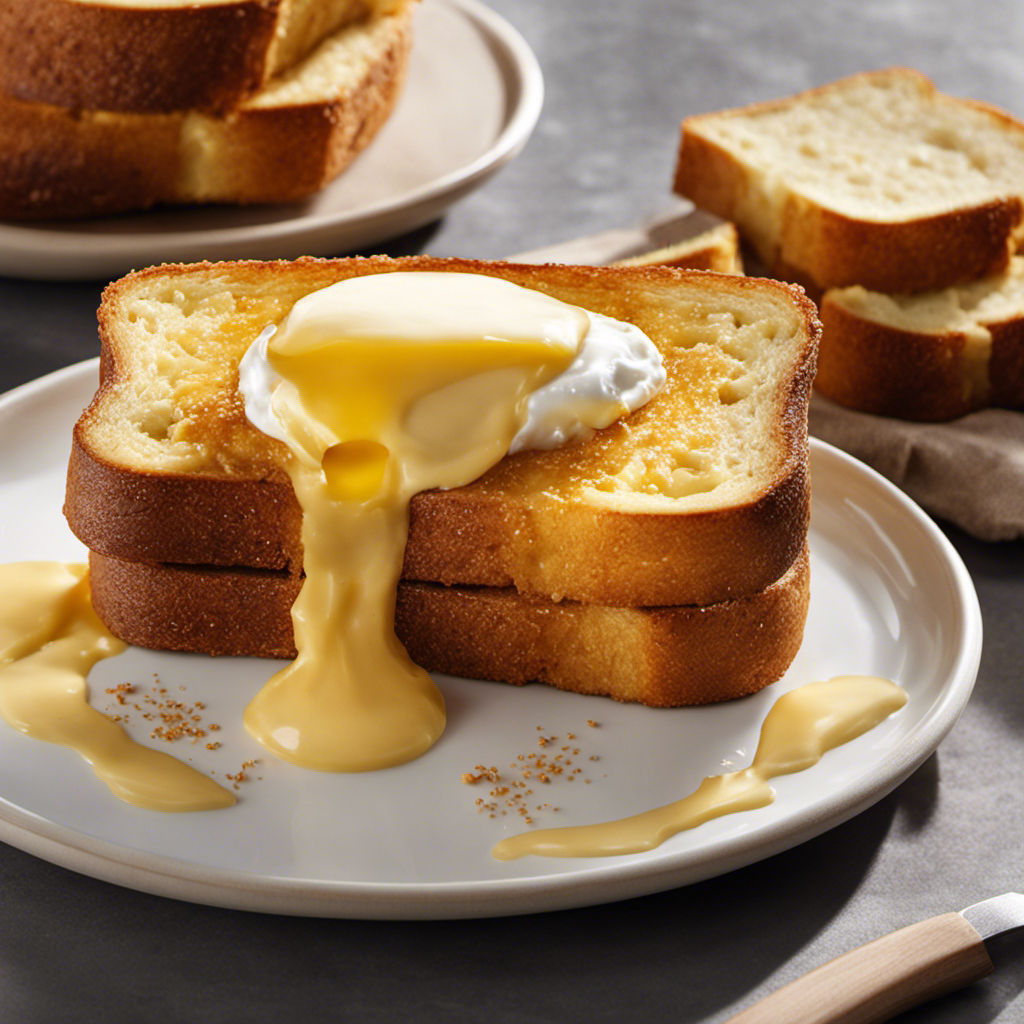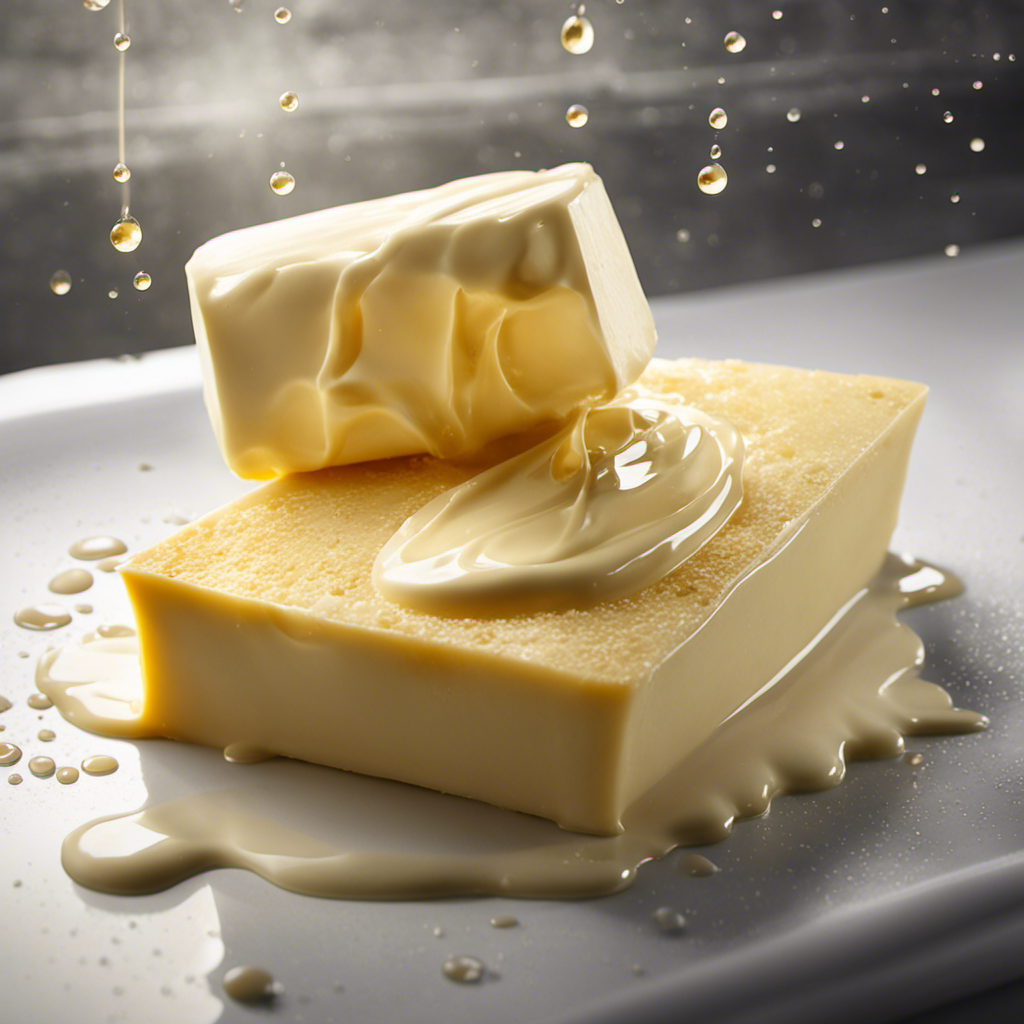As I vigorously move the wooden churn back and forth, its rhythmic action transforms cream into a golden delight. The art of making butter has strong ties to both history and scientific principles, a tradition that has been handed down through generations.
In this article, I will delve into the intricate process of butter churning, exploring the various equipment and techniques used, as well as the crucial role of temperature.
Join me on this buttery journey as we uncover the secrets to creating the perfect batch of churned butter.
Key Takeaways
- Churning butter has a long history and cultural significance, dating back to ancient civilizations.
- The process of churning butter involves breaking down the emulsion of fat and water, separating the fat from the liquid.
- Different types of churns, such as hand-crank and electric churns, can be used to churn butter.
- Temperature control is crucial in butter churning, as it affects the viscosity and structure of the butter.
Historical Background of Churning Butter
Churning butter has been a common practice in households for centuries, with its origins dating back to ancient civilizations. The history of churning butter can be traced back to the time when humans first domesticated animals and started using them for milk production.
In ancient cultures, butter was highly valued for its nutritional and culinary properties. It played a significant role in the diet and economy of many societies, serving as a source of sustenance and a trade commodity.
The process of churning butter involves agitating cream or milk to separate the fat globules from the liquid. This cultural practice has evolved over time, with advancements in technology and methods. Today, while modern equipment has replaced traditional churning methods, the cultural significance of butter-making continues to be cherished in many communities around the world.
The Science Behind Churning Butter
To understand the science behind churning butter, it is important to delve into the concepts of butterfat and emulsion.
Butterfat refers to the fat content present in milk, which is crucial in the churning process.
Emulsion, on the other hand, is the stable mixture of fat and water that is formed during churning, resulting in the creamy texture of butter.
Exploring these key points will provide a comprehensive explanation of how the churning process works and how butter is produced.
Butterfat and Emulsion
When making butter, it is important to understand the role of butterfat and how it contributes to the emulsion. Butterfat, also known as milkfat, is the primary component of butter and gives it its rich flavor and creamy texture. The composition of butterfat can vary depending on the source of milk, but it typically contains about 80% milkfat, 16% water, and 4% milk solids.
To make butter, cream is first separated from the milk and allowed to ripen, which enhances the flavor and aroma. The ripened cream is then churned vigorously. This churning process causes the fat globules to collide and eventually come together. As a result, the emulsion is broken down, separating the fat from the liquid (buttermilk).
After the churning process, the resulting solid mass is kneaded to remove any remaining liquid. This final step ensures that the butter is creamy and spreadable.
Now that we understand the role of butterfat and the initial stages of the butter making process, let’s delve into the churning process explained.
Churning Process Explained
Once the cream has ripened and is ready for the next step, it undergoes a vigorous process that breaks down the emulsion and separates the fat from the liquid.
This process, known as churning, has a long history and holds great historical significance in many cultures.
Churning butter is not just a means of separating fat from liquid; it is also deeply rooted in cultural traditions.
In the past, churning was done by hand, using a churn or a simple wooden container. This labor-intensive process required patience and skill.
Today, modern technology has made churning butter much easier and more efficient.
However, the cultural traditions associated with this process still remain, with many people cherishing the art of churning butter as a way to connect with their heritage and preserve their cultural identity.
Types of Butter Churning Equipment
You can use various types of equipment to churn butter, like a hand-crank churn or an electric churn. These churns are specifically designed to agitate cream and separate the butterfat from the liquid.
Here are three types of churns commonly used for butter churning:
-
Hand-crank churn: This traditional churn requires manual effort to turn the crank, which moves paddles inside the churn, creating the necessary agitation.
-
Electric churn: This modern churn is powered by electricity and automates the churning process. It typically has a motor that rotates paddles or a disk to churn the cream.
-
Barrel churn: This type of churn resembles a barrel and uses gentle rolling or tumbling motions to churn the cream into butter.
Understanding the different types of churns helps in selecting the most suitable butter churner for your needs.
Now, let’s explore the role of temperature in butter churning.
The Role of Temperature in Butter Churning
After discussing the different types of butter churning equipment, let’s now delve into the role of temperature in the churning process. Temperature plays a crucial role in determining the success of butter churning. The effects of temperature on churning are significant and must be carefully considered.
Firstly, the temperature of the cream affects the viscosity and structure of the butter. When the cream is too cold, it becomes thick and difficult to churn. On the other hand, if the cream is too warm, it may not solidify properly, resulting in a less desirable texture.
Secondly, the temperature impacts the speed of churning. Higher temperatures can speed up the churning process, but excessive heat can also cause the butter to melt and lose its desired consistency.
Therefore, maintaining the optimal temperature throughout the churning process is essential for achieving the desired texture and flavor of butter.
Steps to Churn Butter at Home
When it comes to churning butter at home, having the right equipment is crucial for achieving the desired consistency. First and foremost, a quality butter churn is essential. Look for one that is sturdy, easy to use, and has a capacity that suits your needs.
Additionally, having a thermometer to monitor the temperature during the churning process can help ensure optimal results. Finally, don’t forget about butter molds or storage containers to shape and store your homemade butter.
As for tips, maintaining a consistent churning speed and temperature is key. It’s important to churn at a steady pace, neither too fast nor too slow, to achieve a smooth and creamy texture. Additionally, keeping the temperature stable throughout the churn will help prevent the butter from becoming too soft or too hard.
Equipment Needed for Churning
To churn butter, you’ll need a butter churn, a wooden paddle, and a clean glass jar to store the finished product. The type of churn you choose will depend on personal preference and the amount of butter you intend to make.
There are two main types of churns: hand-crank churns and electric churns. Hand-crank churns require manual effort to turn the paddle and churn the cream into butter. Electric churns, on the other hand, automate the churning process with the help of an electric motor.
Once you have the equipment ready, you can start churning butter using various recipes. Some popular churned butter recipes include salted butter, honey butter, and herb-infused butter. These recipes can add flavor and enhance the taste of your homemade butter.
Now, let’s move on to some tips for achieving consistency in your churned butter.
Tips for Achieving Consistency
One way to achieve consistency in your churned butter is by using cold cream straight from the refrigerator. Cold cream helps maintain the proper temperature during the churning process, crucial for smoothness in the final product.
When the cream is too warm, it can result in butter that is too soft and greasy. Conversely, if the cream is too cold, it can take longer to churn and may not achieve the desired texture.
Another tip for consistency is to ensure that your churn is clean and properly sanitized. Residual bacteria or contaminants can affect the quality of the butter.
Additionally, troubleshooting common issues such as over-churning or under-churning can help you achieve the desired consistency.
Understanding these tips will lay the foundation for exploring the factors affecting the quality of churned butter.
Factors Affecting the Quality of Churned Butter
The temperature and freshness of the cream greatly impact the quality of churned butter. When it comes to factors affecting churned butter quality, there are a few key things to consider.
-
Cream temperature: The cream should be chilled to around 50°F before churning. This ensures that the fat molecules in the cream solidify properly during the churning process, resulting in a smoother and creamier butter.
-
Cream freshness: Using fresh cream is essential for producing high-quality butter. Fresh cream contains higher levels of fat, which contributes to a richer and more flavorful end product.
-
Churning technique: The technique used to churn the butter also affects its quality. A slow and steady churning motion allows for better incorporation of air, resulting in a lighter and fluffier texture.
Traditional Techniques Vs. Modern Methods of Churning Butter
Using traditional techniques or modern methods, you can achieve different textures and flavors when churning butter. The choice between traditional techniques and modern equipment depends on personal preferences and the desired outcome. Traditional techniques involve using a hand churn or a wooden butter churn, where the cream is agitated manually or with the help of a crank. This method allows for a slower churning process, resulting in a rich and creamy butter with a distinct homemade taste. On the other hand, modern methods involve using electric butter churns or food processors, which provide a faster and more efficient churning process. This method is ideal for those looking for convenience and consistency in their butter production. Here is a table comparing the two methods:
| Traditional Techniques | Modern Equipment |
|---|---|
| Slower churning process | Faster churning process |
| Rich and creamy texture | Consistent texture |
| Homemade taste | Convenience |
Innovative Uses for Churned Butter
After exploring the traditional and modern methods of churning butter, let’s now turn our attention to the innovative uses for churned butter.
Churned butter, with its rich and creamy texture, can be used in a variety of recipes to enhance both flavor and health benefits. Here are three exciting ways to incorporate churned butter into your culinary creations:
-
Baking: Churned butter adds a luxurious taste and moistness to baked goods like cakes, cookies, and pastries. It also helps create a flaky texture in pie crusts and biscuits.
-
Sauces and dressings: Churned butter can be melted down and used as a base for rich and flavorful sauces. It adds depth and richness to pasta sauces, gravies, and salad dressings.
-
Bulletproof coffee: For a boost of energy and mental clarity, try adding a teaspoon of churned butter to your morning coffee. This popular trend, known as bulletproof coffee, provides sustained energy and promotes focus throughout the day.
Frequently Asked Questions
Can Butter Be Churned Without Any Equipment or Machinery?
No equipment? Hand churning butter is possible using alternative methods or traditional techniques. It requires vigorous shaking or whisking cream until the fat separates from the liquid, forming butter.
How Long Does It Typically Take to Churn Butter at Home?
Typically, it takes around 20-30 minutes to churn butter at home. However, there are ways to speed up the process, such as using warmer cream or adding a pinch of salt. Troubleshooting common issues involves adjusting the temperature and checking the consistency.
Are There Any Health Benefits to Churning Your Own Butter?
There are nutritional advantages to churning your own butter compared to store bought butter. It allows you to control the ingredients and ensure its freshness, resulting in a healthier and tastier choice.
Can Different Types of Milk Be Used to Make Butter?
Different types of milk can be used to make butter, each with its own pros and cons. Experimenting with alternative milks for butter making can lead to unique flavors and textures.
What Are Some Creative Recipes That Incorporate Churned Butter?
I love exploring unique ways to use my homemade churned butter in baking. It adds a rich flavor to cookies, cakes, and breads. I also enjoy learning about traditional butter making techniques from around the world. It’s fascinating!
Conclusion
In conclusion, churning butter is a fascinating process that combines history, science, and culinary artistry.
As I immersed myself in the world of butter churning, I couldn’t help but be captivated by the rhythmic motion of the churn and the rich aroma of freshly churned butter.
The transformation from cream to butter is like witnessing magic unfold before your eyes.
Whether you choose the traditional or modern method, the satisfaction of creating your own homemade butter is unparalleled.
So gather your ingredients, set the temperature just right, and embark on a butter-churning adventure that will leave you with a sense of accomplishment and a dollop of delight.










